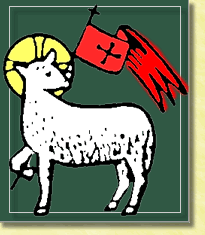A sermon I preached at Trinity School for Ministry chapel. The videoe version can be found here.
Exodus 12:21-28
Psalm 40:1-11
1 Corinthians 1:1-9
John 1:29-42
Almighty God, whose Son our Savior Jesus Christ is the light of the world: Grant that your people, illumined by your Word and Sacraments, may shine with the radiance of Christ’s glory, that he may be known, worshiped, and obeyed to the ends of the earth; through Jesus Christ our Lord, who with you and the Holy Spirit lives and reigns, one God, now and for ever. Amen.

I begin this sermon by talking about a couple of reasons why I don’t trust the liturgical season of Epiphany.
First, the season of Epiphany seems like a contradiction. The word Epiphany comes from the combination of two Greek words: epi meaning “on” and phainen meaning “to show” or “appear,” or, more literally, “shine on.” According to my Greek lexicon, in pagan writings, the word epiphaneia had to do with the visible manifestation of a hidden divinity. So it makes sense that in the liturgical year, Epiphany marks the season following the celebration of the feast of the Magi – the wise men who came from the East to bring gifts to the child Jesus – and it commemorates the first appearance of Jesus to the Gentiles.
The etymology of the word Epiphany comes from a word meaning “to shine,” and it is significant that the season of Epiphany is marked by light imagery. The Magi follow a star that leads them to Bethlehem. The Psalm from the fifth Sunday of Epiphany begins with the words “The Lord is my light and my salvation: Whom Shall I fear?” (Psalm 27:1) This morning’s Psalm is full of imagery of deliverance: “I waited patiently for the Lord; he inclined to me and heard my cry . . . He put a new song in my mouth, a song of praise to our God. Many will see and fear, and put their trust in the Lord” (Psalm 40:1, 3).
So a central theme of the Season of Epiphany has to do with the shining of the light, with images of celebration, and deliverance, of new beginnings. It is a kind of continuation of the celebration of Christmas. Yet Epiphany season takes place in the gloomiest time of the year, especially in Western Pennsylvania, but elsewhere as well. January through March. Gray day after gray day. The name for a chronic depression that affects many people during this time of the year is Seasonal Affective Disorder. The lack of light day after day leads to depression. Why would the church choose to celebrate the Good News of Jesus’ manifestation to the world during a time of year in which it is so hard to see God’s presence anywhere? It doesn’t seem to make sense.
Second, Epiphany feels like a false promise. This season after Christmas commemorates various ways in which God’s incarnation in Christ was manifested: the baptism of Jesus; Jesus’ call of his first disciples; the Sermon on the Mount; the presentation of the baby Jesus in the temple. This morning’s Gospel reading speaks of John the Baptist recognizing Jesus as the “lamb of God who takes away the sin of the world” and the calling of some of Jesus’ first disciples, including Simon Peter (John 1:29, 35-41). It’s a big party! Yet we know what is right around the corner. Epiphany is like a poor step child in the liturgical year. It marks a kind of place marker on the calendar. We need something to do before the Season of Lent, so we just extend Christmas a bit with some “feel good” stuff, “happy stories” about Jesus. And Epiphany is ephemeral. It does not even last a set number of weeks. Sometimes it’s long; sometimes, it’s short. At least for me, one of the consequences is that while I am hearing all of these wonderful stories about Jesus’ baptism and the calling of his disciples, I am looking over my shoulder. I am not going to get too excited or celebrate too much because I know Ash Wednesday is going to be here before I know it, and Lent is going to land on me like a pile of bricks.
Of course, what I just said is deliberately facetious. It reflects a misunderstanding of what is actually going on in the liturgical year. It is easy to imagine the liturgical year as a kind of roller coaster ride. Ordinary Time is like that upward ride up to Christ the King Sunday followed by the sudden downward plunge of Advent. After Advent comes the sudden upward rush of the Twelve Days of Christmas, followed by a slower uphill climb to Ash Wednesday. Once again, there is that plunge to the bottom of the track during Lent, after which there is the upward leap of the Easter Season. This sort of levels off at Pentecost, and Ordinary Time is the end of the Ride. After which the Ride starts all over again in Advent.
Rather than thinking of the liturgical year as a series of contrasts between up and down, light and darkness, it might be more helpful to think of the entire year in terms of the narrative structure of a plot with various main characters. Advent is the season in which we are given the basic outline of the plot. We look forward to the birth of Jesus as the fundamental beginning of the story, while we also look forward to Jesus’ second coming as the final conclusion in which everything gets wrapped up. The Christmas season is the chapter in which we are introduced to the main character. We learn of Jesus’ identity as the Son of God become incarnate, and that his task will be to save his people from their sins. Looking back from Christmas to Advent, we recognize that this same Jesus is the one who will finish the story by creating a new heaven and a new earth. Epiphany is the next chapter in the drama. In Epiphany, we find out more about the central character by hearing stories about the beginnings of his task: his recognition of his vocation at his baptism, the calling of the apostles as the gathering of those who will assist him in his task, the Sermon on the Mount as an account of his basic battle plan.
The season of Lent is the part of the story that turns to the main conflict that lies at the heart of the story. Lent begins with the account of Jesus’ temptation in the wilderness as a challenge and a threat to his undertaking his task. Lent ends with Palm Sunday. Jesus enters Jerusalem in triumph, but at the end his apparent triumph turns to defeat. Holy Week is the account of Jesus’ final conflict with the powers of sin, evil, and death. The triumph of Palm Sunday leads to Jesus’ Last Supper with his followers, culminating in his eventual betrayal by one of his own disciples. Good Friday and Holy Saturday mark what appears to be the eventual defeat of the entire plot. The promise of a new creation and a new earth that we heard about in Advent has now disappointed as Jesus not only has failed to defeat sin, evil, and death, but himself has been defeated by them. The Light of the world who was promised in Epiphany now lies in the darkness of a tomb.
Easter Sunday is of course the defeat of the defeaters. In raising Jesus from the dead, God the Father has shown that Jesus was on the right side of the plot all along. The powers of sin, death, and evil have themselves been defeated by the powers of Light and Life. The Easter Season and the Sundays after Pentecost are the spelling out of what it means that Jesus has risen from the dead. The story is not yet over. The New Heavens and the New Earth promised in Advent have not yet arrived, but Easter is a guarantee that the New Creation is on its way.
We can find a helpful parallel to the basic plot of the Liturgical Year if we compare it to a story with which most of us are likely familiar, J. R. R. Tolkien’s The Lord of the Rings. Advent corresponds perhaps to Tolkien’s The Silmarillion or perhaps The Hobbit. Christmas and Easter correspond to The Fellowship of the Ring. Lent is paralleled by The Two Towers, and Holy Week and Easter tell the story of The Return of the King. The season after Pentecost until the Feast of Christ the King provides parallels to the “Scouring of the Shire.”
Or perhaps we have it backwards. It is not so much that the Liturgical Year resembles the structure of Tolkien’s classic fantasy, but the reverse. Tolkiien was, as we all know, a devout Catholic, and there can be no doubt that the themes of his writings reflect the heart of his faith. In Tolkien’s essay “On Fairy Stories,” he invented the term “Eucatastrophe,” the “Happy Ending” that he suggested is the “true form of fairy-tale.” “Eucatastrophe” denies the possibility of “universal final defeat.” It is “evangelium,” a “fleeting glimpse of Joy, Joy beyond the walls of the world, poignant as grief.” In Tolkien’s epilogue, he wrote that the “Gospels contain a fairy story . . . of a larger kind which embraces the essence of fairy stories.” “The Birth of Christ is the euchatrastophe of . . . history,” and “The Resurrection is the eucatastrophe of the story of the Incarnation.”1 And the basic plot of that fairy-story is also the basic plot of the Liturgical Year.
We can cast some light on the meaning of the liturgical season of Epiphany (pun intended) as a chapter in the plot of the Liturgical Year by looking at today’s lectionary readings in the light of two tools drawn from artistic and literary practice.
Chiaroscuro is an artistic technique in which artists use strong contrasts between light and dark to achieve a sense of three-dimensions while drawing on a two-dimensional surface. Artists like Rembrandt and Vermeer were masters of chiaroscuro. When we look at the lectionary readings for Epiphany, we find that they are not simply images of light, or what I referred to earlier as “happy stories” about Jesus. Rather, light imagery is contrasted with darkness as a kind of literary chiaroscuro. In the Exodus reading, the elders are told to sacrifice a lamb as part of a “rite” that would be practiced as a “statute for you and your children forever.” Even today, Jewish children ask their parents, “What do you mean by this service?” And Jewish parents answer, “It is the sacrifice of the Lord’s Passover, for he passed over the houses of the people of Israel in Egypt, when he struck the Egyptians but spared our houses” (Exodus 12:26-27) Passover marks the deliverance of the people of Israel from slavery, but the light of deliverance contrasts with the darkness of slavery. And the Passover lamb points forward to another Sacrificial Lamb.
In the Gospel reading this morning, John the Baptist identifies Jesus as the “Lamb of God who takes away the sin of the world!” (John 1:29). The identification of Jesus as the “Lamb of God” points forward to Jesus’ sacrificial death and to the words of Caiaphas the high priest who later says “that it is better for you that one man should die for the people, not that the whole nation should perish” (John 11:50). Earlier in John’s gospel, the Evangelist wrote of Jesus that he was the “true light which gives light to everyone,” who was “coming into the world” (John 1:9) But John the Evangelist immediately follows this with “He was in the world, and the world was made through him, yet the world did not know him. He came to his own, and his own people did not receive him” (John 1:10-11). So Epiphany does indeed tell the story of Jesus as the Light of the world, but Epiphany is not a collection of “happy stories” about Jesus. The Light that comes into the world is a Light that shines in surrounding darkness.
Foreshadowing is a literary theme that again evokes imagery of light and darkness. Foreshadowing is a narrative device in which story tellers give a hint of something coming later in the story. Although the lectionary readings do not mention later events explicitly, the reading of later events in the canonical texts make clear that in each instance in the Lectionary readings, there is an element of foreshadowing. The eating of the Passover meal in Exodus is the beginning of the story of Israel’s rescue from slavery and becoming a new people. The lectionary reading closes with “Then the people of Israel went and did so; as the Lord had commanded Moses and Aaron, so they did” (Exodus 12:28).
For those who know the rest of story, however, the Pentateuch goes on to tell not only of Israel’s deliverance from the chariots of Pharoah at the Red Sea and the giving of the Ten Commandments at Sinai, but of the worship of a Golden Calf, and forty years wandering in the wilderness. So the story of Israel’s obedience at that first Passover foreshadows a later disobedience.
Paul’s greeting to the church at Corinth contains an equally paradoxical foreshadowing. Paul writes of the grace that has been given to the Corinthians, and that they are “not lacking in any gift” as they await for the revealing of Jesus. But those who are familiar with what follows in the letter know that it is precisely the Coinrhians’ pride in these gifts that leads to Paul’s rebuking them later.
Finally, the passage in John’s Gospel concludes with Jesus telling his new follower Peter, “You are Simon the son of John. You shall be called Cephas” (John 1:42) But we know that later in the gospel, this same Peter will deny three times that he knows Jesus.
This element of foreshadowing might lead us to discouragement. If before, it seemed that Epiphany was giving us false promises, it might now appear that Epiphany has the opposite effect. There is light, but the light is a light that is opposed by darkness. Epiphany does tells us that God has given us every good gift in Christ, but the giving foreshadows our possible misuse of these gifts, or, like Simon Peter, our very denial that we know Jesus. Epiphany speaks of beginnings, but the beginnings do not always turn out so well.
But here again, the foreshadowing points forward in more than one direction. Exodus speaks of that first Passover Lamb, but Isaiah will later identify that Passover Lamb with a Suffering Servant, and Jeremiah will speak of a new covenant, written on our hearts. The apostle Paul will write some very critical things to the Corinthians, but this does not prevent him from beginning his letter with the promise that he “will sustain you to the end, guiltless in the day of our Lord Jesus Christ. God is faithful, by whom you were called into the fellowship of his Son, Jesus Christ our Lord.” John the Evangelist does indeed write that the light shines in darkness, but he also writes that the darkness has not overcome it. At the end of John’s gospel, the risen Jesus appears to the same Simon Peter who had denied him, and the last words he addresses to him are “Feed my sheep” and “follow me” (John 21:17, 19).
I think what this means is that Epiphany is not at all that sad stepchild of a liturgical season I had suggested at the beginning of my sermon. If Epiphany is about light shining in darkness, then it is perhaps quite fitting that we celebrate it during this most gloomy time of the year. During these gray days and long nights of January and February, we might need once in a while to see glimpses of that light.
If Epiphany is about beginnings, these are beginnings that look in two directions. Epiphany looks back to Christmas, to who Jesus is, but Epiphany also looks forward to what Jesus will accomplish. If stories of Jesus’ baptism and the calling of the apostles fill us with promises of new beginnings, they also rightly look forward to what comes after the beginning. Jesus’ baptism is followed by the temptation in the wilderness. Peter follows Jesus, but he constantly messes things up. Proclaiming in Galilee that God’s kingdom is at hand leads eventually to a cross outside a hill in Jerusalem. Lent is not after all a downer that follows Epiphany. Lent is the logical next step after Epiphany that leads to the cross. Like Jesus’ disciples, we are called to take up our own cross and follow him.
But finally, the contrast between the Light and the surrounding darkness that is at the heart of Epiphany points us to that final glorious Light of Easter morning. The word the Father speaks to Jesus at his baptism, “You are my beloved Son with whom I am well pleased” (Mark 1:11) is fulfilled when God the Father confirms that Jesus is indeed his beloved Son by raising him from the dead, and so defeats death and darkness. The Light of Epiphany shines on our path as well. The beginning steps of Epiphany point us to follow on a path that leads to the final triumph of Easter. Epiphany gives us a glimpse of what J. R. R. Tolkien called the Eucatastrophe of Jesus’ resurrection and a new creation, a “Joy beyond the walls of the world, poignant as grief.”
1 J. R. R. Tolkien, “On Fairy Stories,” 175, 179,in Poems and Stories (Boston New York: Houghton Mifflin: 1994) 113-192;


